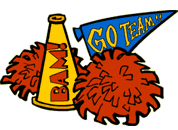CHEERLEADING ACTIVITY CARD
Parts of the Body Worked

Upper & Lower Legs

Body

Arms

Knees & Ankles

Hips & Butt

Lower Back

Heart & Lungs

Just what does it take to do cheerleading?
Gear Up
You’ll need a good comfortable pair of sneakers that provide a lot of support and cushion for your feet. Also, many cheerleaders use spirit-raising tools such as pom-pons and megaphones.
Play it Safe
Today’s cheerleading is super fun, but it’s risky too ÷ especially if you perform stunts. On this team sport, each squad member’s position is key to completing the stunts safely and dazzling the crowd.
Make sure you’re well conditioned for all those kicks, jumps, and splits. Warm up before each practice and game, and do lots of stretching. Focus on stretching your legs and back. If you do stunts and build pyramids, make sure you stretch your arms and shoulders too!
Practice safe stunts! If your squad does lifts, tosses, or builds pyramids, make sure you follow these important safety rules.
Stunt Safety
- Always practice stunts on mats or pads.
- Never attempt a stunt unless a coach is there.
- Always use spotters for each and every stunt.
- If you are new to stunting, start with easier stunts and gradually move up to harder ones.
- Remember that if someone in the stunt yells “Down,” the stunt should come down immediately.
How to Play
When you hear the word “cheerleading,” what do you think of? How about a fast-paced competitive sport for both guys and girls that involves a high level of endurance, strength and precision? For many cheerleaders, that is exactly what cheering is. Cheerleading is coming into its own as a competitive sport. Cheer squads compete up to the national level, developing cheer and dance routines that include complex pyramids, lifts and tosses.
If you’re just starting out, here are some basic cheerleading motions:
Arm Motions
- Goal Post. Arms should be above your head, straight up in the air, and touching the side of your head. Your fists should be closed with your thumbs facing each other.
- High V. From the goal post position, move your arms out slightly wider to form a high V. Fists should be closed and thumbs facing away from your body. Your arms should be slightly in front of you so that you can see your fists out of the corner of your eyes.
- Low V. For this motion, the opposite of a high V, move your arms down into a v-like position by your sides. Keep your fists closed with your thumbs facing away from your body.
- Basic T. Your arms should be straight out on each side, in line with your shoulders. Keep your fists closed with your thumbs facing down, and your arms straight and level. Your body should look like a T.
Jump Tips
There are four main parts to a jump:
- The Prep. Begin with your feet together with your weight on your toes. Move your arms to a high V position and keep your shoulders back.
- The Whip. Next, lift your body up through your shoulders, quickly swinging your arms forward in a circle. Bend at the knees, keeping on the balls of your feet, building up to the lift.
- The Lift. When your arms complete their circle to the high V position, jump off the ground, pushing through your toes. Once you are in the air, pull your legs up toward your arms. Keep your toes pointed, your arms stiff, and your head up.
- The Landing. Bring your legs together quickly so that your feet are together when they hit the ground. Bend your knees slightly to absorb the weight and take the pressure of your legs.
Fun Facts
About 98% of all female college cheerleaders are former gymnasts.
Madonna, Halle Berry, Kim Basinger, Cameron Diaz and Kirsten Dunst were all cheerleaders.
Male celebrities who were cheerleaders include Samuel L. Jackson, Steve Martin, Aaron Spelling, and even President George W. Bush.
Related Links
- Page last reviewed: May 9, 2015
- Page last updated: May 9, 2015
- Content source:



 ShareCompartir
ShareCompartir